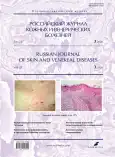Integrative virogeny of skin-type beta papillomaviruses with concurrent progressive dermatoheliosis as a potential risk of malignant carcinogenesis
- 作者: Snarskaya E.S.1, Zhaber A.Z.2
-
隶属关系:
- I.M. Sechenov First Moscow State Medical University, (Sechenov University)
- I.M. Sechenov First Moscow State Medical University (Sechenov University)
- 期: 卷 23, 编号 3 (2020)
- 页面: 132-145
- 栏目: DERMATO-ONCOLOGY
- URL: https://journals.rcsi.science/1560-9588/article/view/48929
- DOI: https://doi.org/10.17816/dv48929
- ID: 48929
如何引用文章
详细
Background: Epidemiological and molecular biological data suggest that papilloma viruses of the beta genus are capable of causing the development of a number of epithelial non-melanocytic skin neoplasms. One of the most probable hypotheses of the influence of cutaneous human papillomaviruses is of great interest, in which they are considered as a cofactor for the promotion of tumor growth of cells already damaged by tumor-initiating epigenetic factors – the result of cumulative ultraviolet-induced damage (UVI), that is, photoaging. Cutaneous papillomaviruses of the genus beta infect the stratified squamous epithelium of the skin, which determines the spectrum of clinical targets, which are the morphological structures of the skin epidermis. The oncogenic strategy of carcinogenic papillomaviruses is enhanced by a number of mechanisms for increasing the aggressiveness of tumor growth, an important feature of which is integrative virogeny, the process of incorporating the viral genome into the cellular chromosomes of epithelial cells.
Materials and methods: The article presents the results of our own studies of the incidence and degree of viral load of HPV genus beta DNA in 80 patients (42 patients with dermatogeliosis of III–IV degrees according to Glogau and epithelial neoplasias, 38 patients without dermatogeliosis) and 40 healthy donors.
Results: We have demonstrated that high rates of detection of papillomaviruses in proliferating tissue identified in immunosuppressive patients with catastrophic manifestations of dermatogeliosis and multiple epithelial neoplasias (papillomas, fibroepitheliomas, keratomas, skin carcinomas) significantly exceed the viral load of virus DNA in normal skin (1.42 ± 0.6 log) and correlate with other clinical and anamnestic signs, in particular, pronounced signs of dermatogeliosis according to Glogau (IV catastrophic stage) and a constitutionally high degree of photosensitivity (II–III according to Fitzpatrick), which indicates the formation of a "pathological tandem", which is local immunosuppression and multiple proliferative foci of the epidermis.
作者简介
Elena Snarskaya
I.M. Sechenov First Moscow State Medical University, (Sechenov University)
编辑信件的主要联系方式.
Email: snarskaya-doc@mail.ru
MD, PhD, DSc., professor of the Department of skin and venereal diseases of I.M. Sechenov First Moscow State Medical University (Sechenov University)
俄罗斯联邦, Moscow, 119991Awad Zhaber
I.M. Sechenov First Moscow State Medical University (Sechenov University)
Email: snarskaya-dok@mail.ru
俄罗斯联邦, Moscow, 119991
参考
- Baseman JG, Koutsky LA. The epidemiology of human papillomavirus infections. J Clin Virol. 2005;32(Suppl. 1):S16-24.
- zur Hausen H. Papillomaviruses and cancer: from basic to clinical application. Nat. Rev. Cancer. 2002;2(5):342-50.
- Bosch FX, Qiao Y.L, Castellsague X. Epidemiology of human papillomavirus infections and its associations with cervical cancer. Int J Gynecol Obstet. 2006;94(Suppl.1):S8-21.
- Scheurer ME, Tortolero-Luna G, Adler-Storthz K. Human papillomavirus infection: biology, epidemiology, and prevention. Int J Gynecol Cancer. 2005;15(5):727-46.
- Majewski S, Jablonska S. Human papillomavirus-assotiated tumors of the skin and mucosa. J Am Acad Dermatol. 1997; 36(5, Pt. 1):659-85.
- Weissenborn SJ, Nindl I, Purdie K, Harwood C, Proby C, Breuer J, еt al. Human papillomavirus-DNA loads in actinic keratoses exceed those in non-melanoma skin cancers. J Invest Dermatol. 2005;125(1):93-7.
- Choi W, Miyamura Y, Wolber R, Smuda C, Reinhold W, Liu H, et al. Regulation of human skin pigmentation in situ by repetitive UV exposure: molecular characterization of responses to UVA and/or UVB. J Invest Dermatol. 2010;130(6):1685-96.
- Bilac C, Sahin MT, Oztürkcan S. Chronic actinic damage of facial skin. Clin Dermatol. 2014;32(6):752-62.
- Battie C, Jitsukawa S, Bernerd F, Del Bino S, Marionnet C, Verschoore M. New insights in photoaging, UVA induced damage and skin types. Exp Dermatol. 2014;23(1):7-12.
- Beissert S, Loser K. Molecular and cellular mechanisms of photocarcinogenesis. Photochem Photobiol. 2008;84(1):29-34.
- Snijders P, Chris J. The value of viral load in HPV detection in screening. HPV today. 2006;8:8-9.
- Korneva LV, Snarskaya ES, Molochkov VA, Polyanskaya AA. Genodiagnostics of HPV beta DNA association with seborrheic keratosis in immunosuppressed and immunocompetent patients. Russian Journal of Skin and Venereal Diseases. 2015;18(2):4-7. (in Russian)
- Korneva LV, Snarskaya ES, Nodelman EK. Molecular genotypic detection of β human papillomavirus DNA in the diagnosis of their association with certain skin epithelial neoplasias in immunocompromised and immunocompetent patients in the mode Real-Time. Russian Journal of Skin and Venereal Diseases. 2016;19(5):260-5.(in Russian)
- Wolff K, Johnson RA, Saaverda A. Photodermatosis and radiation dermatitis. Fitzpatrick’s Color Atlas and Synopsis of Clinical Dermatology. McGraw-Hill Companies; 2006.
- Vierkotter A, Ranft U, Kramer U, Sugiri D, Reimann V, Krutmann J. The SCINEXA: a novel, validated score to simultaneously assess and differentiate between
补充文件






